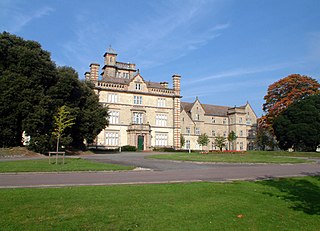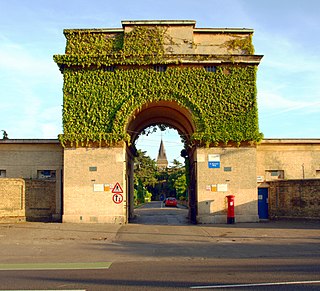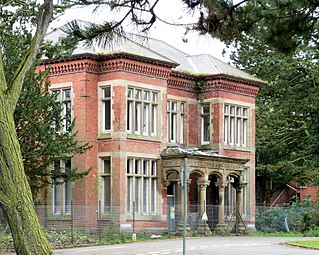
A psychiatric hospital, also known as a mental health hospital, a behavioral health hospital, or an asylum is a specialized medical facility that focuses on the treatment of severe mental disorders. These institutions cater to patients with conditions such as schizophrenia, bipolar disorder, major depressive disorder, and eating disorders, among others.

Austin State Hospital (ASH), formerly known until 1925 as the Texas State Lunatic Asylum, is a 299-bed psychiatric hospital located in Austin, Texas. It is the oldest psychiatric facility in the state of Texas, and the oldest continuously operating west of the Mississippi River. It is operated by the Texas Health and Human Services Commission.

The Lunacy Act 1845 or the Lunatics Act 1845 and the County Asylums Act 1845 formed mental health law in England and Wales from 1845 to 1890. The Lunacy Act's most important provision was a change in the status of mentally ill people to patients.

Fulbourn Hospital is a mental health facility located between the Cambridgeshire village of Fulbourn and the Cambridge city boundary at Cherry Hinton, about 5 miles (8 km) south-east of the city centre. It is managed by the Cambridgeshire and Peterborough NHS Foundation Trust. The Ida Darwin Hospital site is situated behind Fulbourn Hospital. It is run and managed by the same trust, with both hospitals sharing the same facilities and staff pool.

Gartnavel Royal Hospital is a mental health facility based in the west end of Glasgow, Scotland. It provides inpatient psychiatric care for the population of the West of the City. It used to house the regional adolescent psychiatric unit but this has recently moved to a new psychiatric unit at Stobhill Hospital. The Hospital is a venue used by the Mental Health Tribunal for Scotland. Some parts of the hospital are classified as a category A building and are also deemed at risk.

St Bernard's Hospital, also known as Hanwell Insane Asylum and the Hanwell Pauper and Lunatic Asylum, was an asylum built for the pauper insane, opening as the First Middlesex County Asylum in 1831. Some of the original buildings are now part of the headquarters for the West London Mental Health NHS Trust (WLMHT).
Centracare is a Canadian psychiatric hospital in Saint John, New Brunswick.

Whittingham Hospital was a psychiatric hospital in the parish of Whittingham, near Preston, Lancashire, England. The hospital opened in 1873 as the Fourth Lancashire County Asylum and grew to be the largest mental hospital in Britain, and pioneered the use of electroencephalograms (EEGs). It closed in 1995.

Kew Lunatic Asylum is a decommissioned heritage-listed psychiatric hospital located between Princess Street and Yarra Boulevard in Kew, a suburb of Melbourne, Australia. Operational from 1871 to 1988, Kew Asylum was one of the largest asylums ever built in Australia. Later known as Willsmere, the complex of buildings were constructed between 1864 and 1872 to the design of architects G.W. Vivian and Frederick Kawerau of the Victorian Public Works Office to house the growing number of "lunatics", "inebriates", and "idiots" in the Colony of Victoria.

The lunatic asylum, insane asylum or mental asylum was an institution where people with mental illness were confined. It was an early precursor of the modern psychiatric hospital.

The Park Centre for Mental Health is a heritage-listed psychiatric hospital at 60 Grindle Road, Wacol, City of Brisbane, Queensland, Australia. It is one of the largest psychiatric hospitals in Australia. The hospital provides a range of mental health services, including extended inpatient care, mental health research, education and a high security psychiatric unit. It was designed by Kersey Cannan and built from 1866 to 1923. It is also known as Goodna Hospital for the Insane, Goodna Mental Hospital, Woogaroo Lunatic Asylum, and Wolston Park Hospital Complex. It was added to the Queensland Heritage Register on 21 October 1992.

St Augustine's Hospital was a psychiatric hospital in Chartham, Kent, England. It was founded as the second, or East, Kent County Asylum in 1872. In 1948 the hospital became part of the National Health Service and was renamed St Augustine's Hospital. The hospital gained notoriety in the 1970s when it was the subject of a committee of inquiry into malpractice and mismanagement. St Augustine's Hospital closed in 1993 and the site is now occupied by housing, although a few of the original hospital buildings remain.
Woodilee Village is an enlargement to the town of Lenzie in the Kirkintilloch area. The local authority is East Dunbartonshire.

Swanbourne Hospital is a heritage listed former mental hospital located in Mount Claremont, Western Australia. Built in 1904, it was the largest stand-alone psychiatric hospital in Western Australia for much of the twentieth century until its closure in September 1972. The hospital was originally known as Claremont Hospital for the Insane, Claremont Mental Hospital and Claremont Hospital. Following the closure of Claremont Hospital in 1972, the original 1904 section of the hospital functioned as the Swanbourne Hospital until 1985. The site was vacant from 1986, until renovated and reopened primarily as an aged care residence in 2018.

Roundway Hospital was a psychiatric hospital in the parish of Roundway near Devizes, Wiltshire, England. It was originally called the Wiltshire County Lunatic Asylum and later the Wiltshire County Mental Hospital. It opened in 1851 and closed in 1995.

The Old Manor Hospital was a psychiatric hospital in Salisbury, Wiltshire, England. It was established in the early 19th century as a private licensed house called Fisherton House or Fisherton House Asylum, which became the largest private madhouse in the United Kingdom. In 1924, following a change of proprietors, it was renamed Old Manor Hospital and in 1955 it was amalgamated into the National Health Service. From 1813 to 1955 it was owned and managed by members of the same family. The Old Manor Hospital closed in 2003 and was replaced by Fountain Way, a smaller, modern, psychiatric hospital on part of the same site. In 2014 the site was acquired by Quantum Group for development as a residential estate and the conversion of the main building to a hotel.

Stoneyetts Hospital was a psychiatric hospital located in Moodiesburn, near Glasgow. Opened in 1913, Stoneyetts served as an important source of employment for residents within the expanding Moodiesburn area. The function of the institution changed throughout its existence: it originally cared for those with epilepsy, before housing people with intellectual disability, and from 1937 treating those with mental disorders. By the early 1970s there was an emphasis toward psychogeriatric care at the hospital.

Bellsdyke Hospital, also known as Stirling District Lunatic Asylum ('SDLA') or Stirling District Asylum, is a former psychiatric hospital at Larbert, Falkirk council area that was opened in June 1869 and largely closed in 1997. It was an asylum set up by the Stirling District Lunacy Board.

St Matthew's Hospital, formerly known as the Burntwood Asylum, was a mental health facility in Burntwood, Staffordshire, England. Founded as the Second Staffordshire County Asylum in 1864, it was one of three lunatic asylums built in the county of Staffordshire. The plan was for the asylum to house 500 patients, but it was later expanded to provide a capacity for 1302 beds. The asylum complex included the main facility, an electricity plant, gas works, bakery, fire department, farm, mortuary, landscaped and vegetable gardens and cemetery.
The Commissioners in Lunacy for Scotland or Lunacy Commission for Scotland were a public body established by the Lunacy (Scotland) Act 1857 to oversee asylums and the welfare of mentally ill people in Scotland.


















